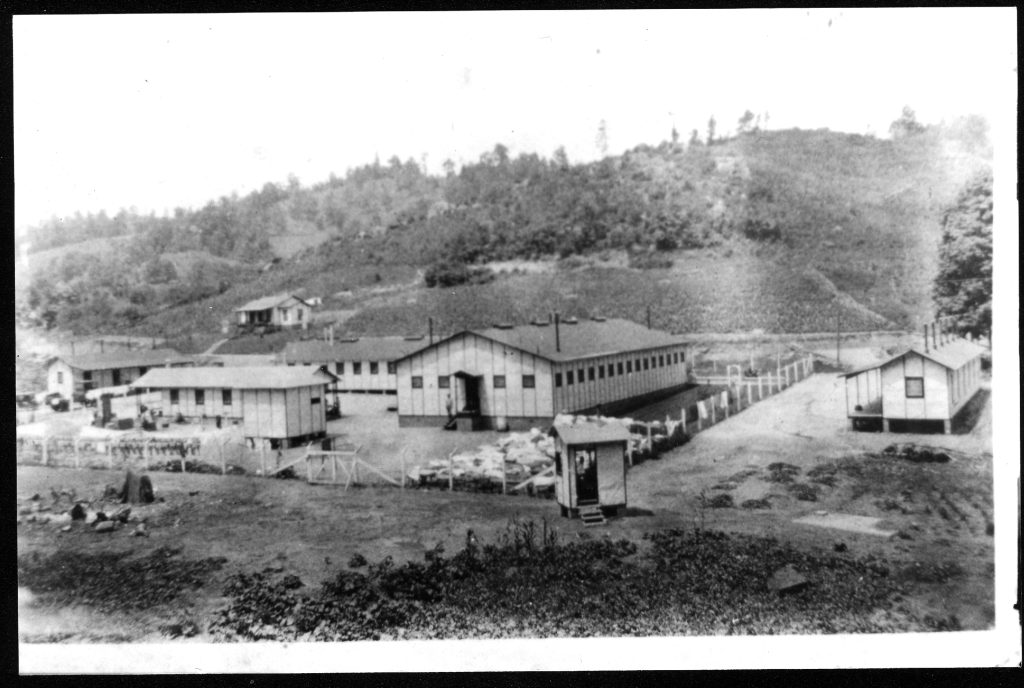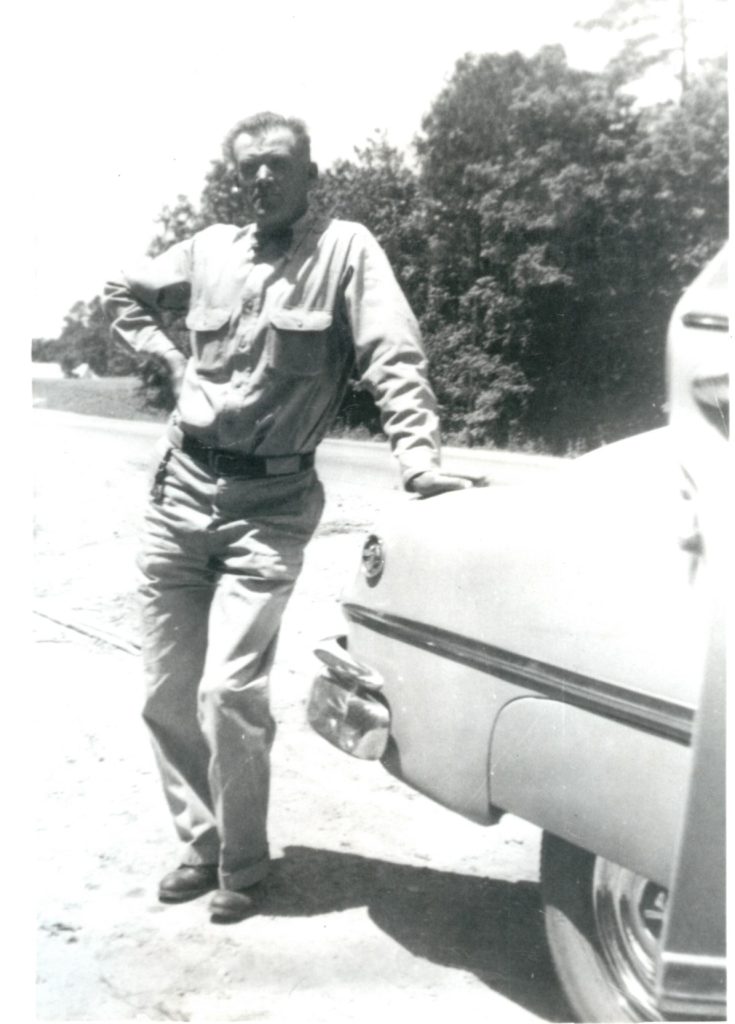Sometimes, even in rural areas like Ashe County, horrific crimes can happen, crimes so heinous they seem lifted from the script of a movie. Such a crime happened in Ashe County on November 23rd, 1959.
At that time, Ashe County, like many other counties in North Carolina, relied on forced labor from convicted criminals to maintain and improve the highways. Prison camps, like the one that stood on Buffalo Road, served as temporary home for these convicted men as they spent their days working under the strict supervision of guards and prison foremen. On the morning of November 23rd, a group of 12 of these convicted laborers were being transported to a jobsite on Cranberry Creek road. However, unlike other mornings, on this day, five of these men had hatched a scheme for escape.
James Waller, George Brown, John Allen Henry, John ‘Junior’ Burgess, and Tommy Styles were each serving time in the Ashe County prison camp for a variety of crimes. Waller a native of Gibsonville, North Carolina, was serving out a short, 3 to 5 year sentence for auto theft. John Allen Henry, a native of Miami, Florida, was also serving a relatively short sentence of 10 years for armed robbery. George Brown was serving 25 years for breaking and entering and robbery.
The two others had a more violent past. Junior Burgess was serving time for a crime committed in 1941. At the age of 15, he had accompanied his cousin to a local gas station. In the process of committing a robbery, Burgess’ cousin shot an killed the gas station attendant and the duo made off with $56, earning Burgess a sentence of 25 to 30 years for accessory to murder.
Tommy Styles was the product of a similarly troubled past. A native of Asheville, he spent much of his young life at the Jackson State Training School, the first juvenile detention facility opened in North Carolina. At the age of 16, Styles had been paroled from Jackson State school and used the opportunity to rob a man at rifle point, stealing $10 in the process. This early crime resulted in a 20 year sentence for robbery.
In addition to these sentences, four of the men, Brown, Waller, Henry, and Burgess, were serving additional time for prior escape attempts. With the addition of Styles into their ring of conspirators, they were now ready to try it again.
In order to get to the jobsite each morning, a truck manned by two armed guards and a foreman left the prison camp with the twelve prisoners who made up the road crew locked in a large cage on the back. On this particular morning, five of those men had a plan: they would attempt to rapidly cut a hole through the bars on the top of the cage, escape through the roof, and leap down onto the guards as the exited the truck, disarming them in the process. However, for at least one of the men, their plan included an additional objective: foreman Fields Absher.
Absher was a native of the Nathan’s Creek community, a son of Horton Absher and Cora Blevins Absher. Both Fields and his brother, Andrew Lincoln, known as Link, had worked for years for the highway department, and, during much of that time, had been assigned as foremen managing crews of convicts. Link had died in 1946 of lung failure, possibly as a result of inhaling quartzite dust during the construction of Highway 16. Fields had continued his work with the prison crews, and in 1959, was a 55 year old grandfather.
Many men who worked as foremen during this period noted the change of demeanor that had begun to appear in the prisoners at the camps. During the 1930s and early 40s, foremen remembered these crews as being largely cooperative and docile; however, by the 1950s, they were becoming more belligerent and difficult to control. Jess Eller, who also worked for the highway department during this time, remembered “They were sassy, and you couldn’t manage them.”
In response to this change, Fields Absher had developed a reputation among his co-workers for being particularly strict with the prisoners. He demanded his crews work diligently, and was known for strictly enforcing expectations with the men under his supervision. Clearly, this approach had engendered resentment among some of the convicts, at least one of whom had decided to exact violent revenge.

When the truck carrying the crew arrived near the low water bridge on Double Springs Church Road, no one in the cab was aware of the trap laying in wait for them. William F. Handy, one of the armed guards, exited the truck, and was immediately tackled from above. His gun was wrestled away from him. One of the convicts took the opportunity to shoot the unarmed Fields Absher, mortally wounding him in the chest. The other guard, Judd Jones, shot in the direction of the escaped criminals, but they placed their stolen gun against the head of William Handy and demanded Judd surrender his weapon, which he did.
Throughout this proceeding, seven prisoners, who wished to stay on the right side of the law, stayed in the cage on the back of the truck. They pleaded with their five escaping peers to abandon their plan and were taken aback by the cold blooded murder of Fields Absher, but, still locked in the cage, could do nothing to prevent it.
Having killed a foreman and escaped, the five men knew they had to flee quickly. They quickly undressed the two guards, put on their uniforms, and locked them, along with the mortally wounded Absher, into the cage with the other prisoners. They then quickly drove the truck up the road, stopping at one of the first houses they came to.
Sue Sheets was at home that morning with her 6 year old daughter. One of the escaping convicts, dressed as a guard, came to the door and knocked. Having regularly seen the truck from the prison camp drive by and suspecting nothing, Mrs. Sheets opened the door and was immediately confronted with a pistol. The escaping criminals demanded the keys to her new white and red car sitting in the driveway, and sped away.
Immediately after their departure, the seven remaining prisoners and the two guards worked to free themselves and rushed Fields Absher to the hospital. However, they arrived too late. Absher was pronounced dead on arrival.
The highway patrol quickly threw up roadblocks in an attempt to trap the getaway car in Ashe County, but the escaped criminals managed to leave the state. Their freedom, however, was short-lived. The day after the escape, on November 24th, George Brown, Tommy Styles, and John Allen Henry were arrested in Jackson, Ohio. Two days later, Junior Burgess was found hiding out in a hotel in Johnson City, Tennessee. James Waller eluded capture for a bit longer, and was able to make it all the way across the country. However, he too was eventually captured in Arizona in January of 1960.
After their capture all the escapees were returned to Ashe for trial. Because of the heinousness of the crime, and the numerous witnesses, justice was swift. By April of 1960, just five months after their attempted escape, all five men pleaded guilty to a range of charges, including armed robbery, escape, and second degree murder. Possibly because of their involvement in the shooting of Absher, Tommy Styles and George Brown received the harshest sentence, with 25 years being added to their sentences. The other three escapees received sentences of 15-20 years for their involvement.
By 1979, each of the men convicted in the escape had been released from prison, with one exception: John ‘Junior’ Burgess had once again escaped from prison in 1968. He was never found and is still considered to be on the run from the law. Were he still alive today, he would be 95 years old. Despite their crimes, these men spent the final years of their lives at home with friends and family, something Fields Absher was never able to experience. His death was a tragic event, an event that, luckily, has few parallels in Ashe County history.
Sources: West, Charles. “I Didn’t Know They Had Killed a Man.” Gastonia Gazette, 24 November, 1959, Pg. 8.
Weaver, Clarice. Interview with Jess Eller. January, 1980.
“Convicts Plead Guilty to Charges.” High Point Enterprise, 7 April, 1960, pg 17.


The photo is the Warrensville camp before it was moved to Buffalo. Today it is the NCDOT bridge maintenance camp. The house on the hillside was the warden’s home. It was expanded and greatly improved by J.W. Faw who purchased it from the state. Today it is the home of retired deputy Brandon Miller and his wife, Robin.
My Daddy also worked for the State Department, he meet the men in the state truck after they shot Fields. I remember that day.I have the front page of the Winston Salem Journal tell about it and remember WBTV from Charlotte coming up to the prison camp and watching it on TV.
Does anybody have a photo of Fields Absher?
I have added one to the original article post.